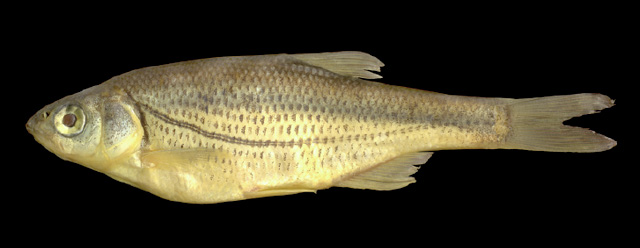Alburnoides maculatus (Kessler, 1859)
Description
Dorsal soft rays (total): 11; Anal soft rays: 14 - 17; Vertebrae: 40 - 42. Diagnosed by having the following combination of characters: pointed caudal fin lobes; clearly forked caudal fins; ventral keel commonly without scales, very rarely scaled up to ½ of its length; head triangular-shaped, elongated; snout clearly pointed though the upper jaw is protruding over the lower jaw, and the tip of the mouth cleft is on the level of the lower margin of pupil or slightly below it; 48-56 (57,58) total lateral line scales; 9-10 scales above lateral line, 4 scales below lateral line; 6-9 gill rakers; pharyngeal teeth commonly 2.5-4.2 (if there are other variants then always four teeth in the longer row of the right ceratobranchial); 40-42 total vertebrae, with a mode of 41; (12)13-14 predorsal vertebrae, with a mode of 13; 20-22 abdominal vertebrae, with a mode of 21, and 19-21 caudal vertebrae, with a mode of 20; the caudal region is always shorter than or equal to the abdominal region, and the difference between the abdominal and caudal numbers is from +3 to 0 with a mode of +1; the most common vertebral formula is 21+20; scales on sides of body with black spots that also outline lateral line; pectoral fin rays 1/13-14, ventral fin rays 1/7, dorsal-fin rays 3/8, branched dorsal-fin rays (7)8(9)½; anal-fin rays 3/11-14; branched anal-fin rays 11-14½, with a mode of 12½ (Ref. 82592).
Common Names
No common names available.
Taxonomic Hierarchy
Kingdom: Animalia
Phylum: Chordata
Class: Teleostei
Order: Cypriniformes
Family: Leuciscidae
Genus: Alburnoides
Species: Alburnoides maculatus (Kessler, 1859)
Climate Zone
Location
Biology
Life cycle and mating behavior
Habitat
benthopelagic
